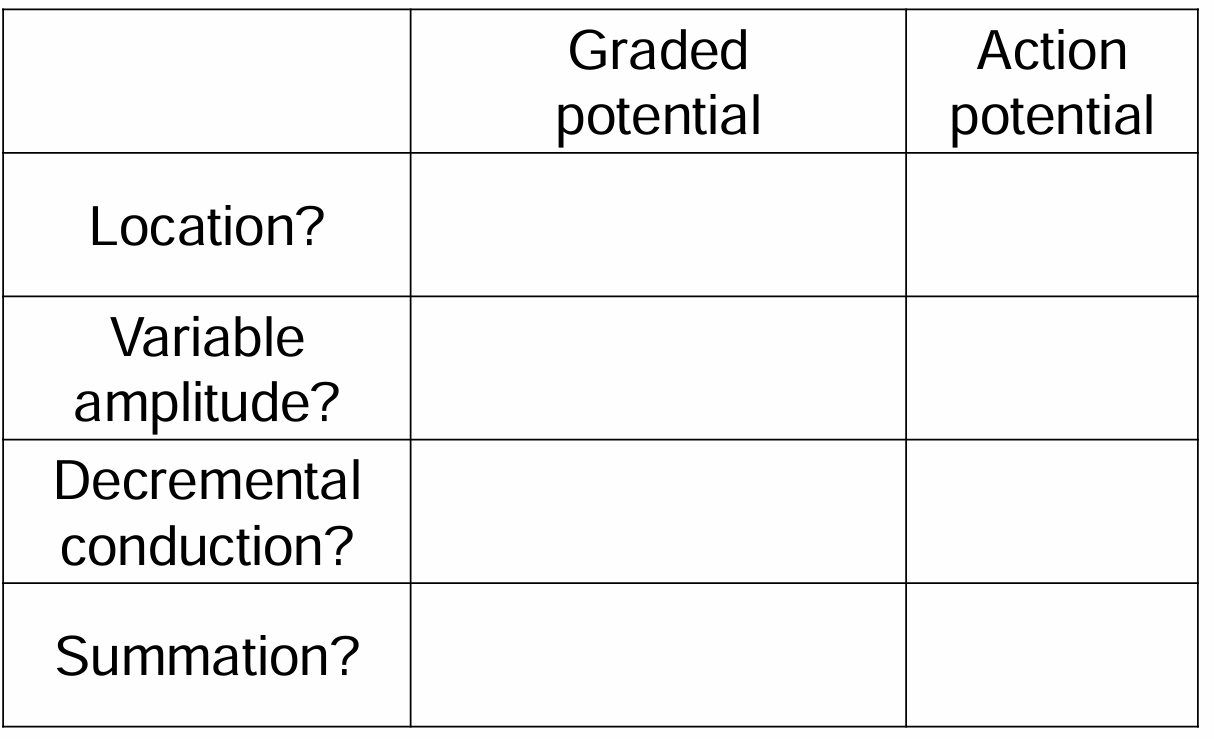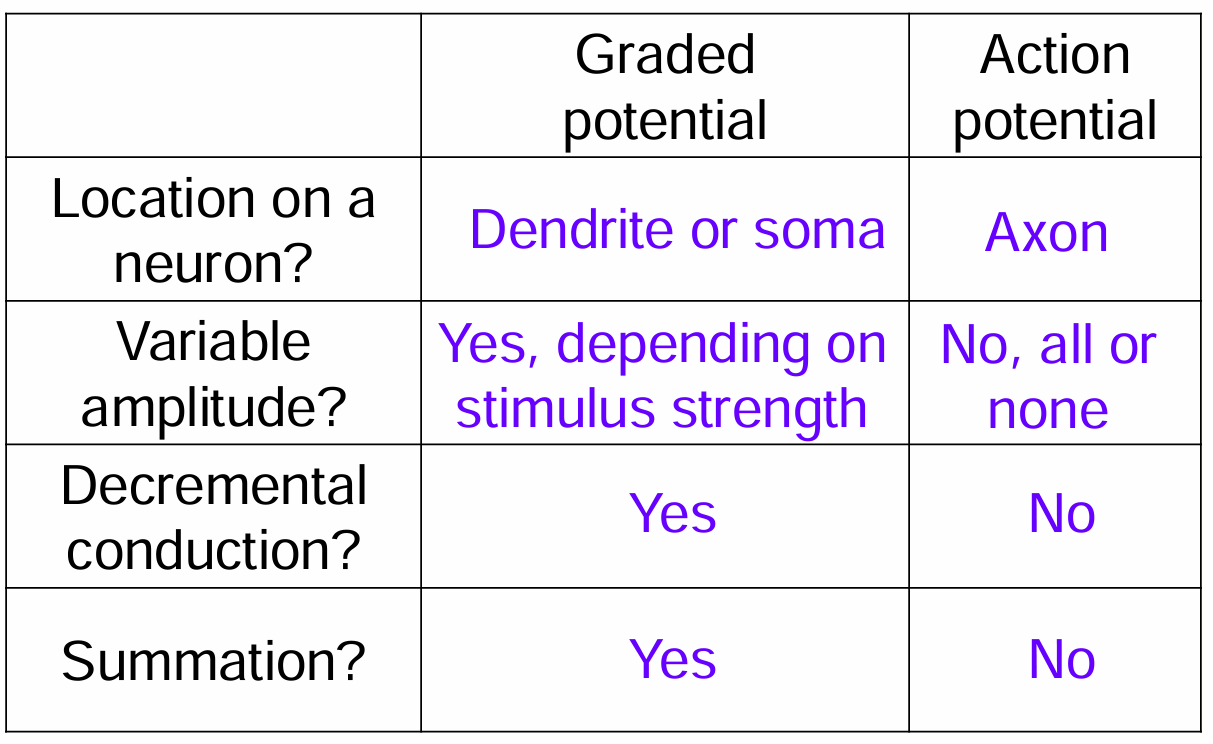Graded Potentials and Action Potentials
1/44
There's no tags or description
Looks like no tags are added yet.
Name | Mastery | Learn | Test | Matching | Spaced |
|---|
No study sessions yet.
45 Terms
Neurons are _____
excitable
How does the signal get from the synapse to the nerve terminal? (3)
Excitable cells have gated channels that cause ion shifts (eg influx of Na+)
Change in the membrane potential
Generates an electrical signal (graded or action) that sends information from one area of the cell to another
Graded potential
Long or short?
Where?
Short; Dendrite
Action potential
Long or short?
Where?
Long; axons
Generation of a graded potential in a dendrite (3)
Ligand (neurotransmitter or chemical stimulus) binds to a receptor on a dendrite
Opens a Na+ channel (one example) (Ligand-gated channel)
A graded potential is generated
Will the graded potential generated from the opening of a ligand-gated Na+ channel cause a depolarization or hyperpolarization?
A. Depolarization
B. Hyperpolarization
A. Depolarization
Steps of a graded potential
Channel opens and ion (eg Na+) fluxs in
Channel closes and K+ leak and NaK-ATPase brings it back to RMP
Repolarization is passive (another channel does not open)
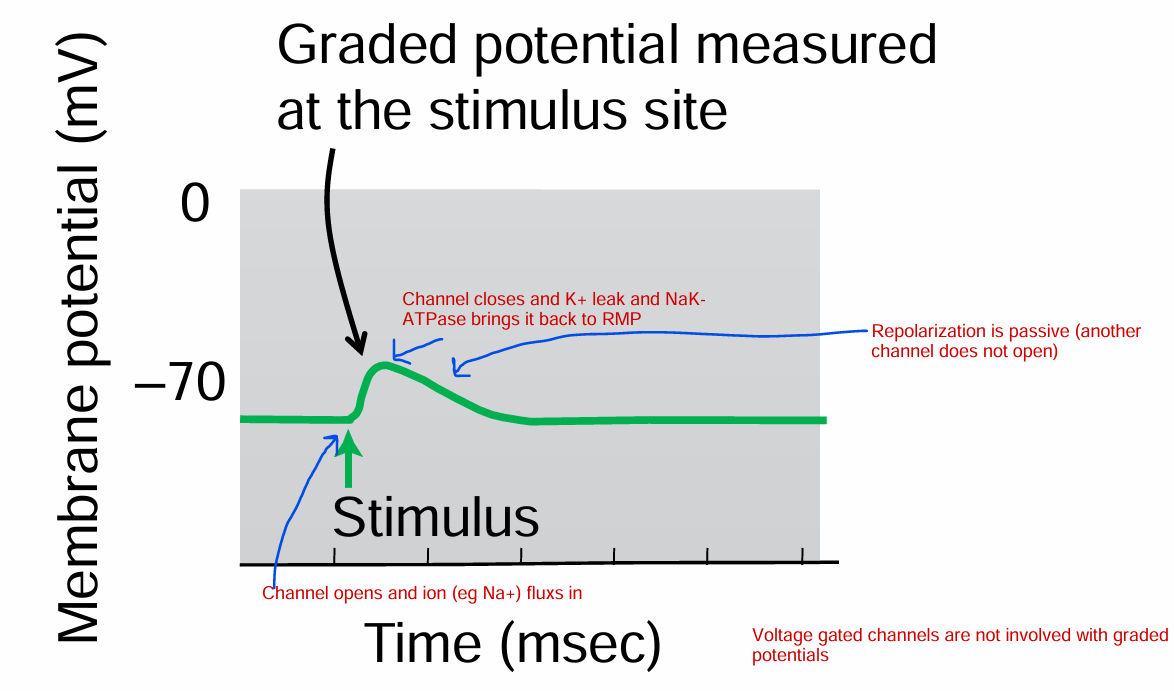
Graded potential is measured where/ when?
Graded potential measured at the stimulus site/ peak
What is the stimulus for a graded potential?
oftentimes the stimulus is a chemical stimulus (ligand), or a mechanical stimulus
If a stronger stimulus causes more ligand gated Na+ channels to open, what happens to the amplitude of the graded potential that is produced?
A. Larger
B. Smaller
C. No change, graded potentials are caused by opening of voltage-gated Na+ channels
A. Larger
KEY: Amplitude increases with increasing stimulus strength***
Decrementally
Amplitude decreases with distance from the origin
What happens if a second stimulus occurs before the membrane has repolarized from a first stimulus?
We have two stimulis causing more Na+ ligand channels to open
Summation
Not all graded potentials are Depolarizations. Some are
Some are hyperpolarizations
Depends on the neurotransmitters involved, the channel involved, and the ion flux
Fun facts about action potentials (2)
Typically involve large changes in membrane potential
Typically involve voltage gated Na+ and K+ channels
A graded potential is generated by opening of ___ and spreads from ___
by opening of ligand-gated Na+ channels and spreads from
the dendrite to the cell body to the axon hillock
Many times to generate an action potential you need:
A stronger stimulus for the graded potential to reach the axon hillock
Summation
If the graded potentials reach the axon hillock which contains voltage gated Na+ and K+ channels
An action potential can be generated
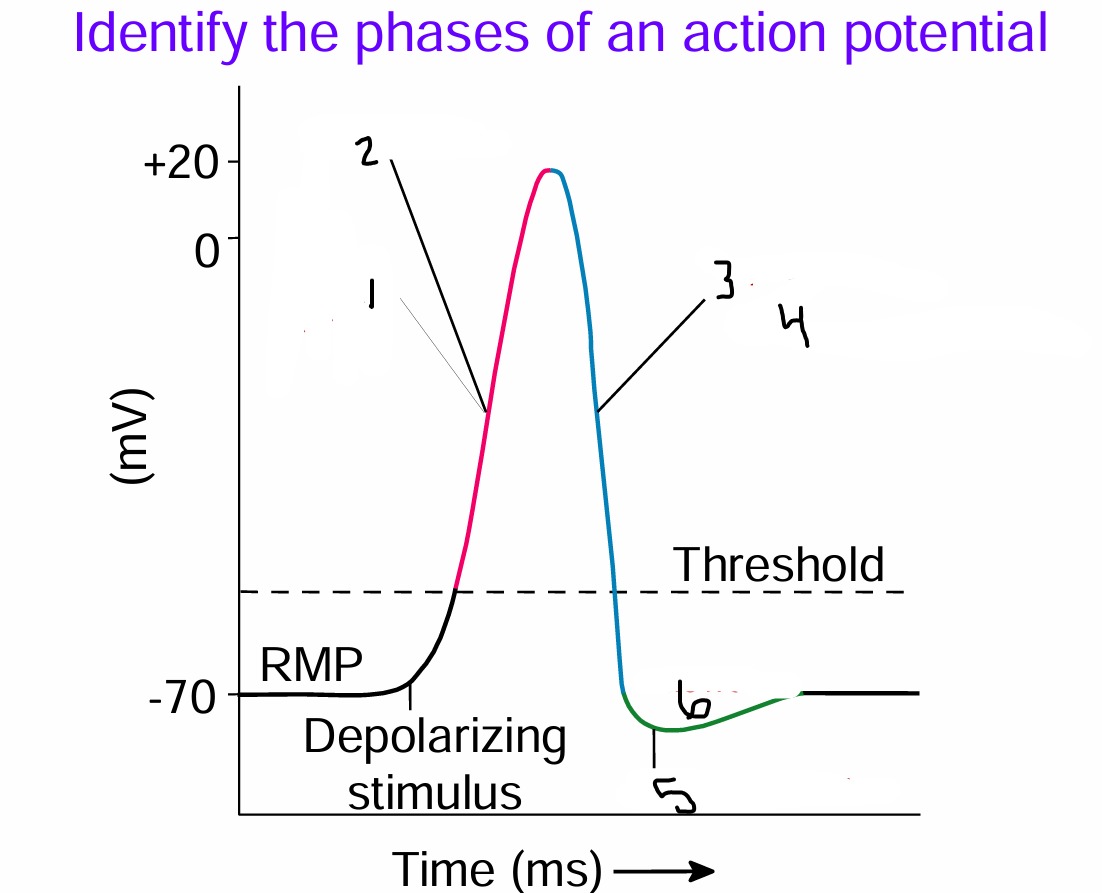
Identify the phases of an action potential
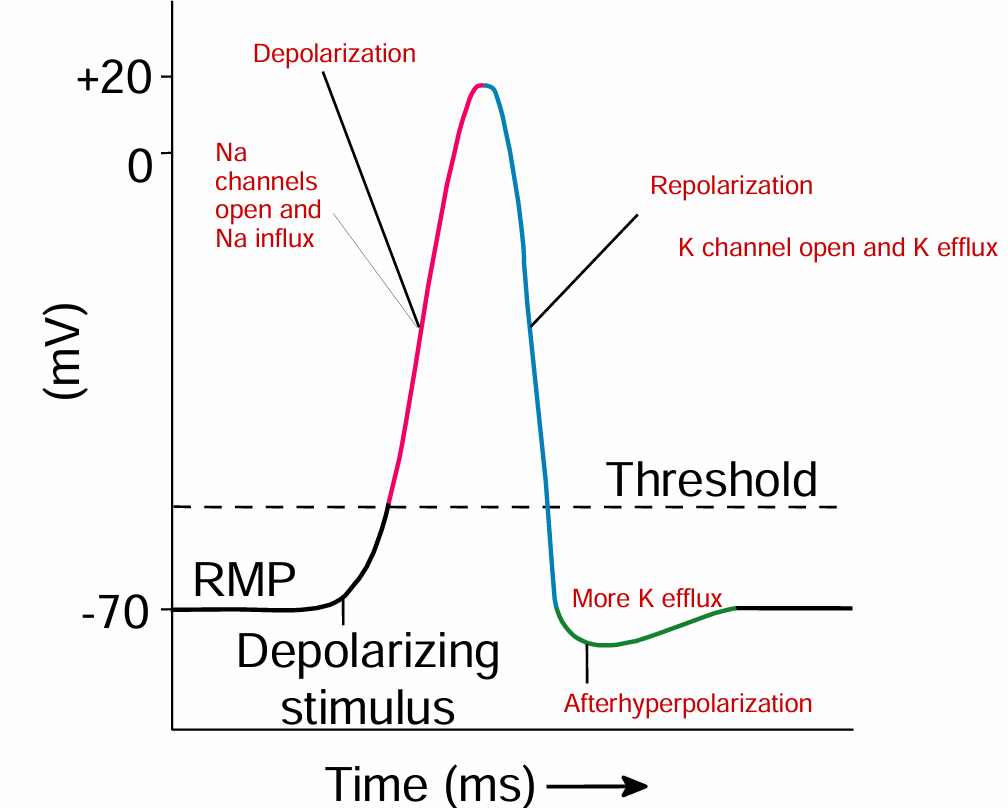
Voltage gated Na+ channel has
Activation gate
Inactivation gate

Channels when membrane is at rest
Na+ Inactivation gate is open, activation gate is closed
K+ channels closed
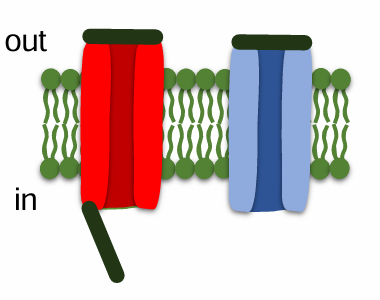
Channels when membrane is depolarized
Na+ channels open, Na+ Influx
K+ channels closed
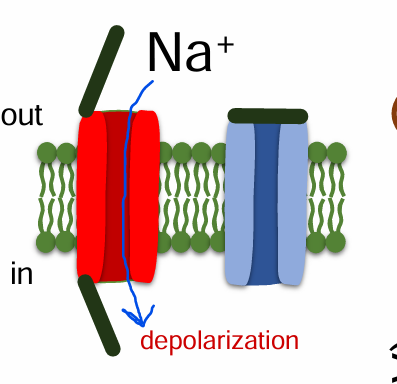
Channels when membrane is repolarized
Na+ inactivation gate is closed
K+ Channels open, K+ Efflux
Channels at after-hyperpolarization
Na+ inactivation gate is closed
K+ Channels open, K+ Efflux
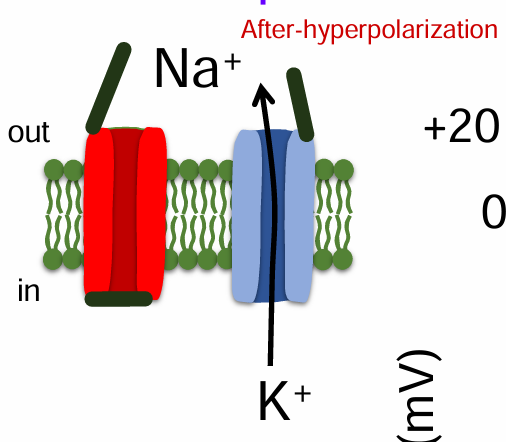
What causes all of the changes (i.e. opening and closing of the gates) in the Na+ and K+ channels?
A. Ligand changes
B. Voltage change
C. Time changes
B. Voltage change
What is the purpose of the inactivation gate on the Na+ channel?
A. It’s a backup in case the activation gate
doesn’t close
B. It’s a backup in case the activation gate
doesn’t open
C. To prevent the net efflux of Na+ during
repolarization
D. To prevent another action potential from
occurring during repolarization
D. To prevent another action potential from occurring during repolarization
Can a second stimulus activate more Na+ channels during the depolarization phase of the AP?
No because it is an all or nothing phenomenon
Can a second stimulus activate Na+ channels during the repolarization phase of the AP?
No because the inactivation gate is closed
Absolute refractory period
Contains depolarization and repolarization. At this point, another stimulus cannot change it.
Can a second stimulus activate Na+ channels during the after hyperpolarization phase of the AP?
Yes. the 2nd stimulus need to be stronger than a ‘normal’ stimulus because farther away from the threshold
Relative refractory period
Happens during After-hyperpolarization. Need a stronger stimulus to activate an action potential but can have a second stimulus.
Is the amplitude of an action potential higher
with a stronger stimulus – for example a loud
noise vs a whisper, or something that is
mildly painful vs very painful?
No. Irrespective of the strength of the stimulus, the amplitude of the AP is the same. AP does not have summation.
So how does the brain know that it is a
loud noise and not a whisper?
By the frequency of the action potentials
What is the physiological purpose of the refractory period?
Enables individual electrical signals to propagate down the axon. It is key in determining the direction of action potential propagation
Why is the propagation of the action potential important?
The first action potential is exactly the same as the last action potential. No decrement so it can travel long distances.

Propagation of an action potential down an unmyelinated axon pt 1 (3)
Membrane depolarizes Na channels activate
Inside positive, outside negative
Local current starts to depolarize the adjacent membrane
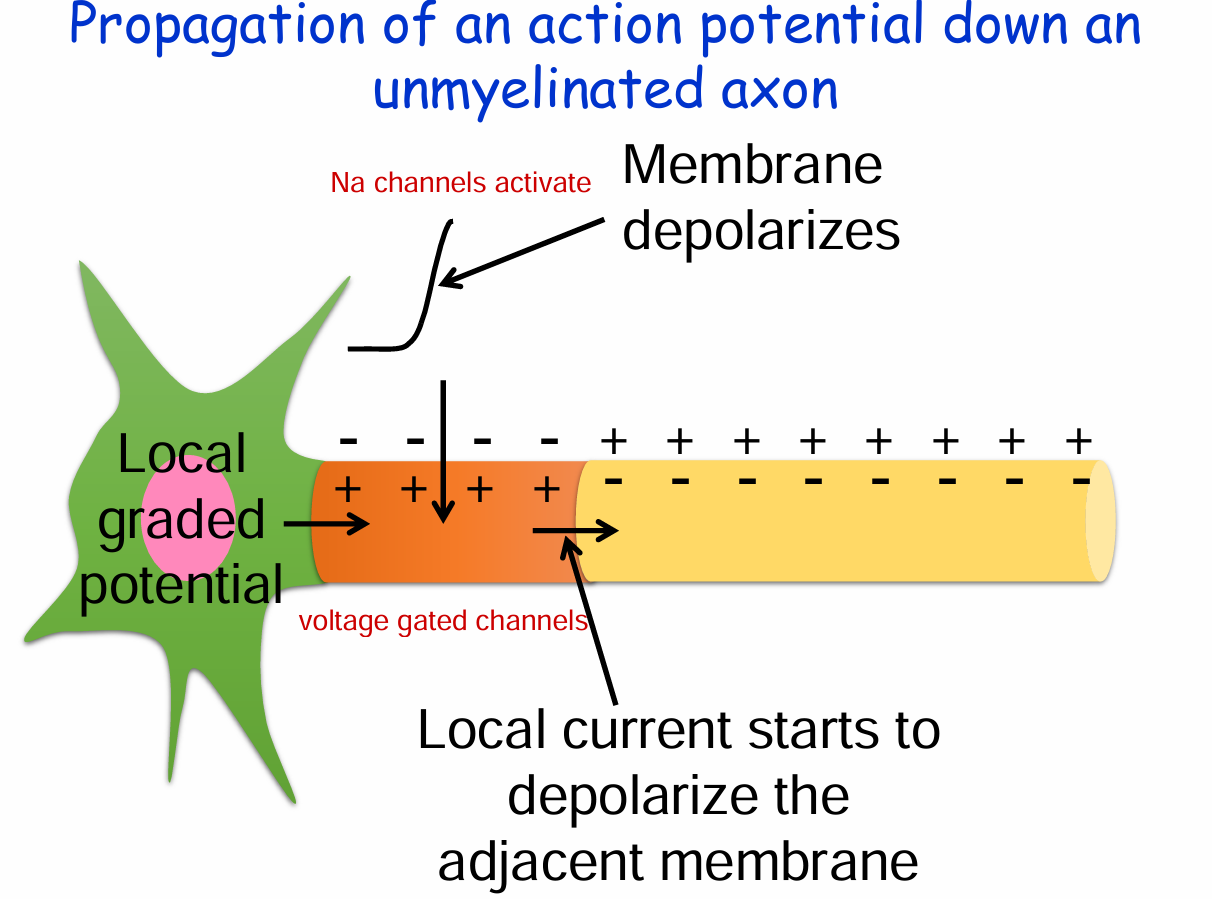
Propagation of an action potential down an unmyelinated axon pt 2 (4)
First part starts to repolarize as Na channels deactivate and K channels open
Inside negative, outside positive
Cannot generate another AP
The second part starts to depolarize and only move in one direction

Propagation of an action potential down an unmyelinated axon is relatively slow. How can this be sped up?
Myelin sheath/ insulating parts of the axon.
Saltatory conduction
The electrical impulse “jumps” down the axon
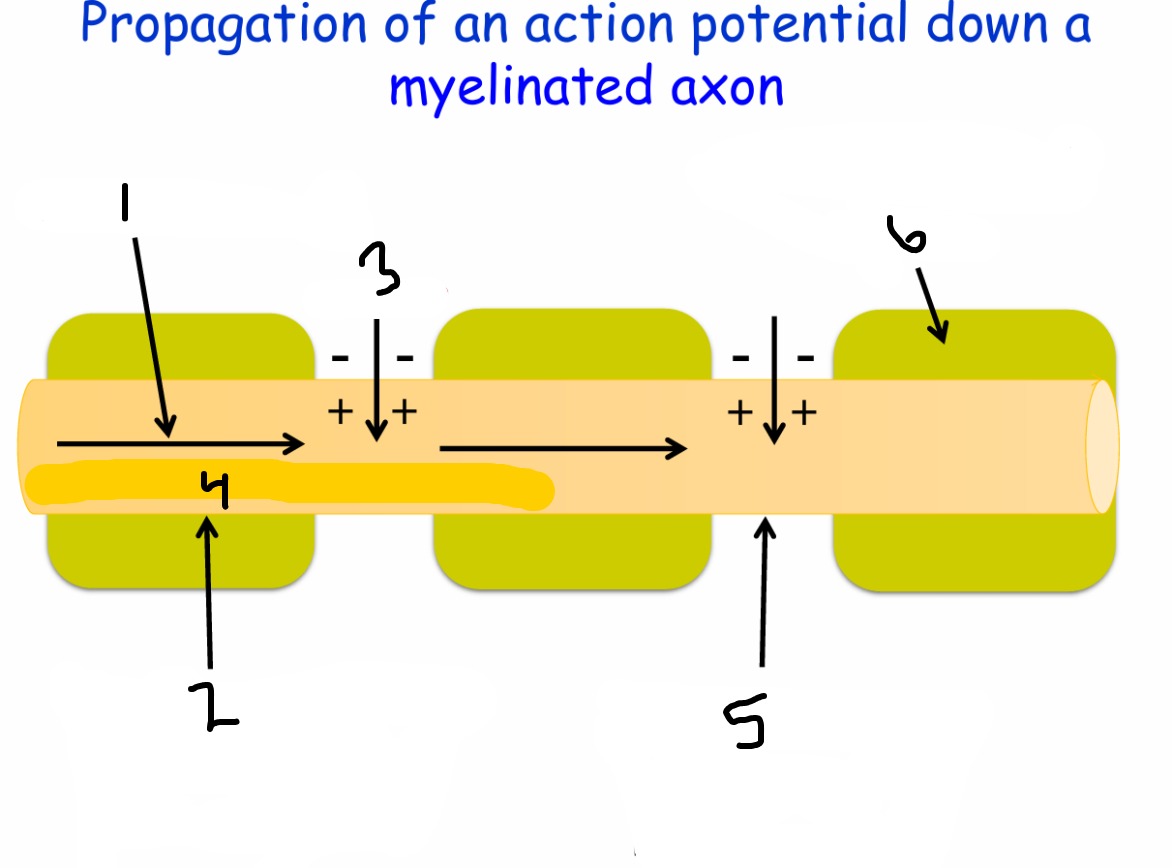
Propagation of an action potential down a myelinated axon
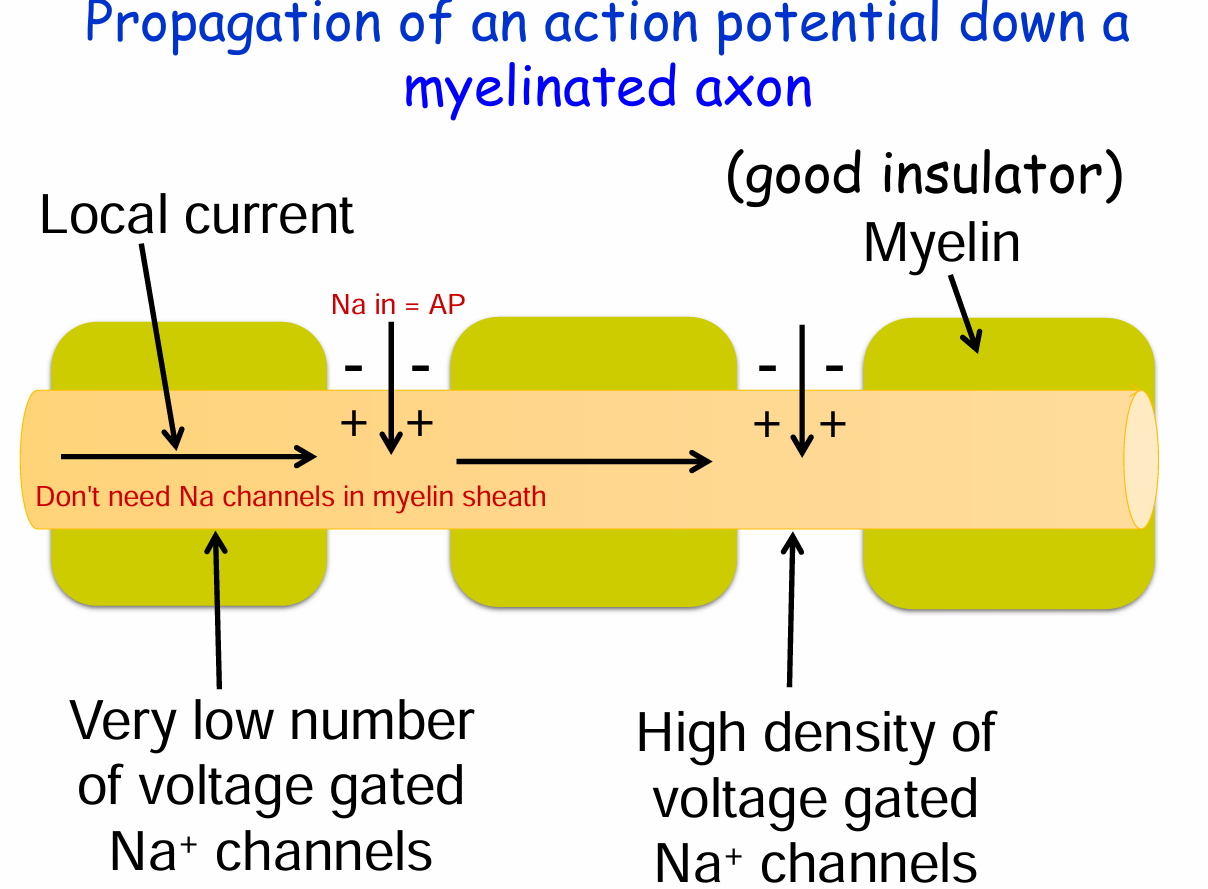
A neuron in a petri dish is stimulated at the
point indicated by the triangle. If this
generates an action potential at that point,
which way does it propagate?
A. Both directions
B. Neither direction
C. Toward the axon terminals
D. Towards the cell body
A. Both directions
Traveling both ways. Typically goes one way because refractory period but no refractory period if placed in middle of axon.
A 6-year-old boy is brought to his pediatrician
after his parents noticed that he had difficulty
moving his arms after a soccer game. About 10
minutes after leaving the field, the boy became
so weak that he could not stand for about 30
minutes. Questioning revealed that he
complained of muscle spasms and weakness
after eating bananas. He was diagnosed with
hyperkalemic periodic paralysis. What do you
think is hyperkalemia?
A. Low intracellular K+
B. Low blood levels of K+
C. High intracellular K+
D. High blood levels of K+
D. High blood levels of K+
Caused by a mutation in the gene for the voltage gated Na+ channel
When the boy became hyperkalemic, this most likely caused his neurons and muscle cells to:
D. Depolarize
E. Hyperpolarize
D. Depolarize
How might the hyperkalemia affect the Na+
channels on his neurons and muscle cell?
A. The prolonged hyperpolarization will cause
the Na+ channels to open at a faster rate
causing the paralysis or muscle weakness
B. The prolonged hyperpolarization will cause
the Na+ channels to inactivate causing the
paralysis or muscle weakness
C. The prolonged depolarization will cause the
Na+ channels to open at a faster rate
causing the paralysis or muscle weakness
D. The prolonged depolarization will cause the
Na+ channels to inactivate causing the
paralysis or muscle weakness
D. The prolonged depolarization will cause the
Na+ channels to inactivate causing the
paralysis or muscle weakness
